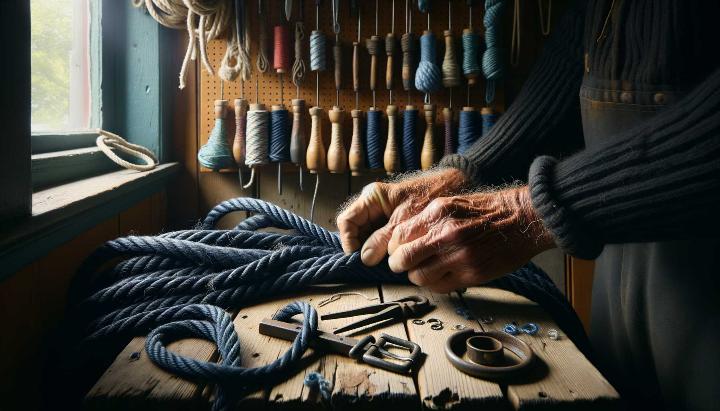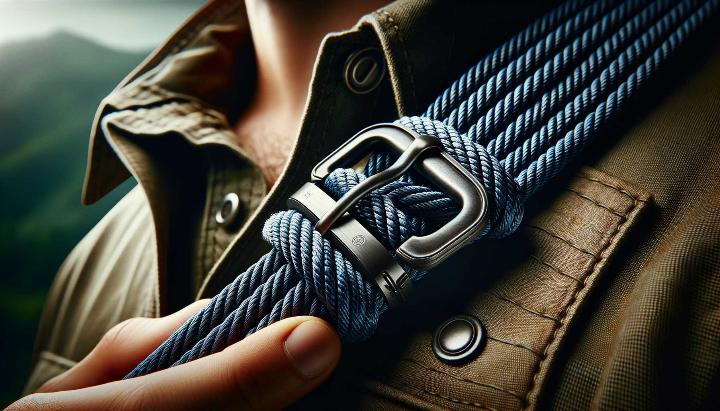Have you ever found yourself in a situation where the strength of your rope could mean the difference between success and failure? Whether you're an off-road enthusiast, a seasoned sailor, or a professional in the construction industry, mastering strong splice knot techniques with synthetic rope is a game-changer. But here's the kicker: not all synthetic ropes are created equal.
Enter iRopes, a leading manufacturer that's revolutionising the rope industry with their innovative buckle technology. Imagine a rope that can be customised to your exact length requirements and boasts superior strength compared to traditional options. It's not just a pipe dream – it's a reality that's changing the way we approach rope splicing.
In this comprehensive guide, we'll dive deep into the world of rope splice knots, exploring everything from the basics to advanced techniques specifically tailored for synthetic winch rope. You'll discover why iRopes' buckle technology is a must-have for anyone serious about rope work, and how it can elevate your splicing game to new heights. Whether you're a novice looking to learn the ropes (pun intended) or a seasoned pro seeking to refine your skills, this post has something for everyone. So, are you ready to unlock the full potential of your synthetic rope and master the art of the perfect splice?
Understanding the Basics of Rope Splicing
As an avid sailor and rope enthusiast, I've come to appreciate the art of rope splicing over the years. There's something incredibly satisfying about creating a strong, permanent connection in a rope that can withstand the toughest conditions. Let's dive into the world of rope splicing and explore why it's such a valuable skill for anyone working with ropes.
What is Rope Splicing?
Rope splicing is a technique used to join two ropes together or create a loop at the end of a rope by interweaving its strands. Unlike knots, which can weaken a rope significantly, a well-executed splice maintains up to 95% of the rope's original strength. This makes splicing an essential skill for anyone serious about rope work, whether you're rigging a sailboat or setting up a winch line for off-road adventures.
Types of Rope Splices
There are three main types of splices you'll encounter in rope work:
- Eye splice: Creates a permanent loop at the end of a rope, perfect for attaching to anchors or other fixtures.
- Back splice: Used to prevent the end of a rope from fraying, acting as a more secure alternative to whipping.
- Short splice: Joins two ropes together, creating a strong and permanent connection.

Advantages of Splicing Over Knots
You might be wondering, "Why bother with splicing when I can just tie a knot?" Well, let me tell you, the benefits of splicing are significant:
- Strength retention: Splices maintain up to 95% of a rope's strength, compared to knots which can reduce strength by 40-60%.
- Durability: A properly executed splice is permanent and won't come undone under load.
- Streamlined profile: Splices create a smooth connection that won't snag on obstacles or equipment.
- Aesthetics: Let's face it, a well-done splice just looks more professional than a bulky knot.
Now that we've covered the basics, are you ready to try your hand at splicing? In the next section, we'll walk through a step-by-step guide to creating an eye splice, one of the most versatile and useful splices you can master. Remember, practice makes perfect, so don't get discouraged if your first attempts aren't picture-perfect. With time and patience, you'll be splicing like a pro!
Step-by-Step Guide to Tying a Splice Knot Rope
Now that we've covered the basics of rope splicing, let's dive into the nitty-gritty of creating a splice knot rope. As someone who's spent countless hours perfecting this technique, I can assure you that with a bit of patience and practice, you'll be splicing like a pro in no time.
Preparing the Synthetic Rope for Splicing
Before we get our hands dirty, it's crucial to properly prepare your synthetic rope. This step can make or break your splice, so pay close attention:
- Choose the right rope: Ensure you're using a high-quality synthetic rope, like those offered by iRopes, which are designed for optimal splicing performance.
- Measure carefully: Determine the length of your splice based on your project requirements. Remember, iRopes offers customization options to meet specific length needs.
- Secure the rope: Use tape or a whipping to prevent the rope from unravelling as you work.
- Unlay the strands: Carefully separate the rope strands for the length of your intended splice.

Detailed Instructions for Creating a Basic Splice Knot
Now, let's walk through the process of creating a basic eye splice, one of the most versatile splice knots:
- Form the eye: Create a loop in the rope, determining the size of your eye splice.
- Mark your tucks: Use a marker to indicate where each strand will be tucked into the rope's body.
- Begin tucking: Starting with the middle strand, tuck it under a strand in the main body of the rope.
- Continue the pattern: Tuck the remaining two strands, following a consistent over-under pattern.
- Repeat the process: Continue tucking each strand at least three times, gradually tapering the tucks.
Remember, the key to a strong splice is maintaining consistent tension throughout the process. Take your time and don't rush – precision is paramount here.
Tips for Ensuring a Secure and Reliable Splice Knot
To elevate your splicing game and create knots that will stand the test of time, keep these tips in mind:
- Maintain rope tension: Keep the rope taut as you work to ensure a tight, secure splice.
- Count your tucks: For synthetic ropes, aim for at least five full tucks to ensure maximum strength.
- Taper your splice: Gradually reduce the number of strands you tuck to create a smooth, streamlined finish.
- Heat-seal the ends: For synthetic ropes, carefully melt the strand ends to prevent fraying.
- Test your splice: Always test your splice under controlled conditions before putting it to real-world use.
As you practice, you'll develop a feel for the rope and the splicing process. Don't get discouraged if your first attempts aren't perfect – even the most seasoned sailors had to start somewhere!
Pro Tip: When working with iRopes synthetic ropes, take advantage of their buckle technology for enhanced strength and easier customization. This innovative feature can significantly simplify the splicing process while ensuring top-notch performance. To learn more, check out our guide to iRopes' double braid anchor ropes.
Remember, mastering the art of splice knot tying takes time and practice. But with these steps and tips in your toolkit, you're well on your way to creating strong, reliable splices that will serve you well in any situation. Happy splicing!
Exploring Advanced Techniques for Synthetic Winch Rope Knots
As an avid off-roader and winch enthusiast, I've learned that mastering advanced techniques for synthetic winch rope knots is crucial for both safety and performance. Let's dive into some expert-level tips that will take your winching game to the next level.
Incorporating iRopes' Buckle Technology for Enhanced Strength
One of the game-changers in the world of synthetic winch ropes is iRopes' innovative buckle technology. I remember the first time I used it - it was like discovering a secret weapon for rope strength. Here's why it's so impressive:
- Customisable strength: The buckle allows you to adjust the rope's strength based on your specific needs.
- Easy length adjustment: You can quickly modify the rope length to suit different winching scenarios.
- Improved load distribution: The buckle helps spread the load more evenly, reducing wear on the rope.
To incorporate this technology, simply thread your synthetic rope through the buckle and adjust as needed. It's a game-changer for those tricky recoveries where every bit of strength counts.
Customising the Splice Knot to Meet Specific Length Requirements
Sometimes, you need a rope that's just the right length for a particular job. That's where customising your splice knot comes in handy. Here's a step-by-step guide to tailoring your rope length:
- Determine the desired length for your application.
- Unravel the rope strands at the point where you want to create the splice.
- Create a loop of the desired size.
- Begin the splice by weaving the strands back into the rope's body.
- Continue the splice for at least 5-7 tucks to ensure strength.
Remember, practice makes perfect. Don't be discouraged if your first few attempts aren't flawless - even the pros had to start somewhere!

Troubleshooting Common Issues and Mistakes When Tying Synthetic Winch Rope Knots
Even experienced winchers can run into issues. Here are some common problems I've encountered and how to solve them:
- Rope slippage: If your knot is slipping, try adding an extra tuck or two to increase friction.
- Weakened rope: Avoid sharp bends in your knots, as these can reduce rope strength. Aim for gradual curves instead.
- Difficulty untying: For knots that may need to be undone, consider using a EStar stopper or buntline hitch. These are strong yet relatively easy to untie.
- Fraying ends: Always remember to heat-seal the ends of your synthetic rope to prevent fraying. For additional insights on maintaining synthetic ropes, explore our guide on synthetic winch lines.
Have you encountered any of these issues? How did you overcome them? Sharing experiences is a great way for us all to learn and improve our winching skills.
Safety First: Always inspect your synthetic winch rope and knots before each use. Even a small nick or wear spot can significantly weaken the rope and lead to dangerous situations.
Remember, mastering these advanced techniques takes time and practice. But with persistence and the right tools - like iRopes' synthetic ropes and buckle technology - you'll be handling even the toughest winching challenges with confidence. So, are you ready to take your winching skills to the next level?
Benefits of Using iRopes' Synthetic Ropes for Splicing
As a seasoned rope enthusiast, I've had the pleasure of working with various types of ropes over the years. But when it comes to splicing, iRopes' synthetic ropes have truly revolutionised the game. Let me share with you why these ropes have become my go-to choice for all my splicing needs.
Durability and Strength Advantages
The moment you hold an iRopes synthetic rope, you can feel the difference. It's remarkably lightweight, yet don't let that fool you - these ropes pack a serious punch when it comes to strength. In fact, they boast an impressive strength-to-weight ratio that outperforms traditional steel cables.
- Unmatched strength retention: With proper splicing techniques, iRopes' synthetic ropes can retain up to 100% of their original strength. That's a game-changer for heavy-duty applications.
- Superior abrasion resistance: These ropes can take a beating without showing signs of wear, making them ideal for rugged environments.
- Chemical and UV resistance: Whether you're working in harsh marine conditions or under the scorching sun, iRopes' synthetic ropes maintain their integrity where others might fail.

Easy Splicing and Versatility
One of the standout features of iRopes' synthetic ropes is their ease of splicing. The smooth, consistent fibre structure makes the splicing process a breeze, even for those new to the technique. For an in-depth look into various rope types and their uses, check out our detailed guide on double braided polyester ropes.
Here's a quick overview of the splicing process:
- Unravel the rope strands
- Interweave the strands following iRopes' specific pattern
- Taper the splice for a smooth finish
- Heat-seal the ends to prevent fraying
The versatility of these ropes is truly remarkable. I've used them for everything from marine applications to off-road vehicle recovery. The ability to create custom splices opens up a world of possibilities for various industries, including:
- Maritime: Mooring lines, anchor rodes, and sailboat rigging
- Construction: Lifting and securing heavy loads
- Outdoor recreation: Rock climbing, zip lines, and adventure parks
- Agriculture: Towing and securing equipment
Performance in Harsh Environments
If you've ever worked with ropes in challenging conditions, you know how crucial reliability is. iRopes' synthetic ropes excel in harsh environments where other ropes might falter. Their kernmantle construction provides excellent protection against abrasion, making them ideal for rugged terrains and industrial settings.
I remember a particularly gruelling off-road expedition where our winch line was put to the test. The iRopes synthetic winch rope performed flawlessly, maintaining its strength and flexibility even after multiple recoveries through muddy, rocky terrain. It's this kind of dependability that sets iRopes apart from the competition.
Pro Tip: When working in abrasive environments, consider using iRopes' protective sleeves to further extend the life of your synthetic rope. It's a small investment that can significantly increase the longevity of your gear.
Have you had experience with synthetic ropes in challenging conditions? I'd love to hear about your adventures and how these modern marvels of rope technology have impacted your work or hobbies.
In conclusion, iRopes' synthetic ropes offer a winning combination of strength, durability, and versatility that makes them the perfect choice for splicing applications across various industries. Whether you're a professional rigger or an outdoor enthusiast, these ropes will elevate your splicing game to new heights. So why not give them a try on your next project? You might just discover a new favourite tool in your rope arsenal.
In the world of rope splicing, understanding the nuances of the rope splice knot is beneficial for those using synthetic options. iRopes offers superior synthetic ropes, notably with advanced buckle technology that enhances strength and allows for customization to meet specific needs like buttonhole length requirements. Different splice knot ropes can retain up to 95% strength, far surpassing traditional knots. The blog provides a detailed guide on creating and securing splices, making it invaluable for both beginners and seasoned users seeking to improve their synthetic winch rope knot techniques.
Discover the Benefits of Customised Rope Solutions
Above is our inquiry form for exploring iRopes' custom rope solutions further. Filling it in connects you with our specialists who can help ensure your rope projects achieve the strength and precision needed for your specific applications.